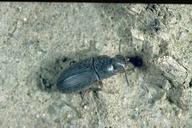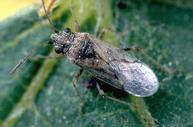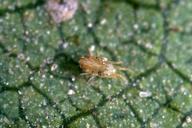
Darkling beetle adult
Identification tip: The adult is dull bluish black or brown, and about 1/4 inch long. The tips of the antennae are often enlarged, distinguishing them from predaceous ground beetles, which are beneficial. |

False chinch bug adult
Identification tip: The adult is small, about 1/8 inch long, gray to light brown, and looks somewhat like a small lygus bug. |
 Webspinning spider mite adult
Identification tip: To the naked eye, spider mites appear as tiny moving dots. They live in colonies, mostly on the lower surfaces of leaves. During the season mites range from yellow to green to black depending on age and host food. All have dark spots. Spider mites can be problematic particularly where soils are alkaline. |

Botrytis blossom and shoot blight damage
Identification tip: Dead leaves remain attached to shoots killed by Botrytis. Rains in May and June can lead to blight during fruit development. |
Photo not available
Epicarp staining (caused by rain)
Identification tip: When rain occurs early in the fruiting season, it can cause staining of the epicarp similar to that of stink bugs, leaffooted bugs, and small plant bugs. |
|


